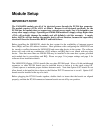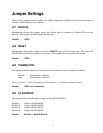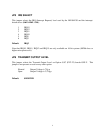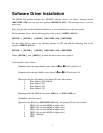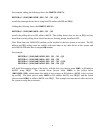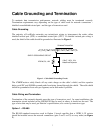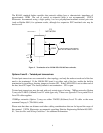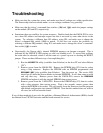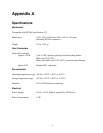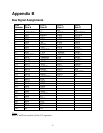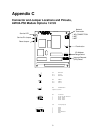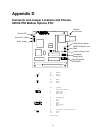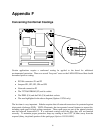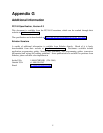10
Troubleshooting
• Make sure that the system has power, and make sure that all voltages are within specification.
The Neuron chip does not tolerate under- or over-voltage conditions very gracefully.
• Make sure that the driver’s command-line switches (/P# and /Q#) match the jumper settings
on the module (JP4 and JP5, respectively)
• Sometimes there are conflicts for system resources. Double-check that the LM104-P50 is set to
use a base I/O address and interrupt request line that is not used by some other device in the
system. Try selecting a different base I/O address, using JP4, and make sure to change the
driver’s command-line switch (/P#) to match. If this does not resolve the problem, try
selecting a different IRQ number, using JP5, and make sure to change the driver’s command-
line switch (/Q#) to match.
• Occasionally, the Neuron chip’s internal EEPROM memory can become corrupted. This is
indicated by the SERVICE LED staying on solid, not blinking at all. To correct this problem,
the node must be rebooted, which is not the same as a power up reset or shorting the RESET
jumper. There are three different ways of accomplishing this:
1. Run the NODEUTIL utility (available from Echelon) on the host PC and select Reboot
(“R”).
2. Remove power from the LM104-P50. Remove the EPROM chip (U2) from its socket
using a chip extractor. Replace the EPROM with an EPROM programmed with
EEBLANK.NRI (also available from Echelon). Turn the power on. The service LED
should go off while the Neuron blanks its internal EEPROM. It will then come on solid
and stay that way. Remove power from the LM104-P50, remove the EEBLANK
EPROM and replace it with the original EPROM, then restore power.
3. Remove power from the LM104-P50. Remove the EPROM chip (U2) from its socket
with a chip extractor, then restore power. Wait a few seconds, remove power, then
replace the EPROM in its socket. This will usually force the Neuron to load the program
and default configuration into internal EPROM. Note that this method does not work in
all cases, but will not harm the board.
If any of these methods do not solve the problem, a Returned Material Authorization (RMA) should
be obtained from VISTA Electronics and the board returned for service.



